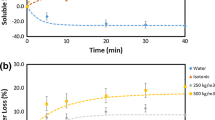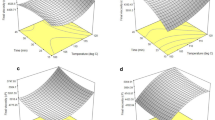Abstract
Purpose
The process parameters of ultrasound power output (20–100%), osmotic concentration using salt solution (10–30% w/v), and process time (10–30 min) were investigated and optimized for ultrasound-assisted osmotic dehydration of yellow cassava using response surface methodology.
Methods
The experiment was carried out with ultrasound generator at a fixed frequency of 20 kHz at a room temperature. Box Behnken design consisted of three factors at three levels each which made up to 17 experimental runs were used in the experiment. Two slices of yellow cassava were used per experimental run.
Results
The result showed that linear terms of power and concentration had significant effects on water loss, solid gain, and weight reduction. The optimized values that would give minimum solid gain and maximum water loss and weight reduction were time of 10 min, ultrasound power of 100%, and concentration of 20.24% w/v. This gave predicted values of 23.05, 0.58, and 22.90% for water loss, solid gain, and weight reduction, respectively.
Conclusion
The optimized values could be useful in the processing of yellow cassava in order to achieve increased shelf life.




Similar content being viewed by others
Explore related subjects
Discover the latest articles and news from researchers in related subjects, suggested using machine learning.References
Akinwale, M. G., Aladesanwa, R. D., Akinyele, B. O., Dixon, A. G. O., & Odiyi, A. C. (2010). Inheritance of β-carotene in cassava (Manihot esculenta crantza). International Journal of Genetics and Molecular Biology, 2(10), 198–201.
AOAC. (2000). Official methods of analysis of AOAC international. Association of Official Analysis Chemists International. https://doi.org/10.3109/15563657608988149, 9, 471.
Awad, T. S., Moharram, H. A., Shaltout, O. E., Asker, D., & Youssef, M. M. (2012). Applications of ultrasound in analysis, processing and quality control of food: a review. Food Research International., 48, 410–427. https://doi.org/10.1016/j.foodres.2012.05.004.
Duah, E., Parkes, E., Baah, R., Acquatey-Mensah, A., Danquah, A., Kirscht, P., et al. (2016). Consumption trends of white cassava and consumer perceptions of yellow cassava in Ghana. Journal of Food and Nutrition Research (Newark, Del), 4(12), 814–819. https://doi.org/10.12691/jfnr-4-12-8.
Eren, I., & Kaymak-Ertekin, F. (2007). Optimization of osmotic dehydration of potato using response surface methodology. Journal of Food Engineering, 79(1), 344–352. https://doi.org/10.1016/j.jfoodeng.2006.01.069.
FAOSTAT. (2015). Food and agricultural commodities production/countries by commodity. http://faostat3.fao.org/browse/rankings/countries_by_commodity/E Accessed 9 April 2015.
Fernandes, F. A. N., Rodrigues, S., Gaspareto, O. C. P., & Oliveira, E. L. (2006). Optimization of osmotic dehydration of papaya followed by air-drying. Food Research International, 39(4), 492–498. https://doi.org/10.1016/j.foodres.2005.10.004.
Fernandes, F. A. N., Oliveira, F. I. P., & Rodrigues, S. (2008). Use of ultrasound for dehydration of papayas. Food and Bioprocess Technology, 1(4), 339–345. https://doi.org/10.1016/j.foodres.2005.10.004.
Garcia-Noguera, J., Oliveira, F. I. P., Gallão, M. I., Weller, C. L., Rodrigues, S., & Fernandes, F. A. N. (2010). Ultrasound-assisted osmotic dehydration of strawberries: effect of pretreatment time and ultrasonic frequency. Drying Technology, 28(2), 294–303. https://doi.org/10.1080/07373930903530402.
Li, H., Zhao, C., Guo, Y., An, K., Ding, S., & Wang, Z. (2012). Mass transfer evaluation of ultrasonic osmotic dehydration of cherry tomatoes in sucrose and salt solutions. International Journal of Food Science and Technology, 47(5), 954–960. https://doi.org/10.1111/j.1365-2621.2011.02927.x.
Nowacka, M., Tylewicz, U., Laghi, L., Dalla Rosa, M., & Witrowa-Rajchert, D. (2014). Effect of ultrasound treatment on the water state in kiwifruit during osmotic dehydration. Food Chemistry, 144, 18–25.
Oladejo, A. O., & Ma, H. (2016). Optimization of ultrasound assisted osmotic dehydration of sweet potato (Ipomea batatas ) using response surface methodology. Journal of the Science of Food and Agriculture, 96(August), 3688–3693. https://doi.org/10.1002/jsfa.7552.
Oladejo, A. O., Sobukola, O. P., Awonorin, S. O., & Adejuyigbe, S. B. (2014). Evaluation and optimization of steam and lye peeling processes of sweet potato (Ipomea batatas) using response surface methodology (RSM). International Journal of Food Engineering, 10(2), 329–338. https://doi.org/10.1515/ijfe-2013-0051.
Oladejo, A Olayemi, Ma, H., Qu, W., Zhou, C., & Wu, B. (2017). Effects of ultrasound on mass transfer kinetics, structure, carotenoid and vitamin C content of osmodehydrated sweet potato (Ipomea Batatas). Food and Bioprocess Technology, 1–11. 10.1007/s11947-017-1890-7.
Omodamiro, R. M., Oti, E., Etudaiye, H. A., Egesi, C., Olasanmi, B., Ukpabi, U. J., et al. (2012). Production of fufu from yellow cassava roots using the odourless flour technique and the traditional method. Evaluation of carotenoids retention in the fufu, 3(5), 2566–2572.
Ozen, B. F., Dock, L. L., Ozdemir, M., & Floros, J. D. (2002). Processing factors affecting the osmotic dehydration of diced green peppers. International Journal of Food Science and Technology, 37(5), 497–502. https://doi.org/10.1046/j.1365-2621.2002.00606.x.
Prinzivalli, C., Brambilla, A., Maffi, D., Lo Scalzo, R., & Torreggiani, D. (2006). Effect of osmosis time on structure, texture and pectic composition of strawberry tissue. European Food Research and Technology, 224(1), 119–127. https://doi.org/10.1007/s00217-006-0298-9.
Shamaei, S., Emam-Djomeh, Z., & Moini, S. (2012). Ultrasound-assisted osmotic dehydration of cranberries: effect of finish drying methods and ultrasonic frequency on textural properties. Journal of Texture Studies, 43(2), 133–141. https://doi.org/10.1111/j.1745-4603.2011.00323.x.
Simal, S., Benedito, J., Sánchez, E. S., & Rosselló, C. (1998). Use of ultrasound to increase mass transport rates during osmotic dehydration. Journal of Food Engineering, 36(3), 323–336.
Siucińska, K., & Konopacka, D. (2014). Application of ultrasound to modify and improve dried fruit and vegetable tissue: a review. Drying Technology, 32(11), 1360–1368. https://doi.org/10.1080/07373937.2014.916719.
Talsma, E. F., Brouwer, I. D., Verhoef, H., Mbera, G. N. K., Mwangi, A. M., Maziya-dixon, B., … Melse-boonstra, A. (2016). Biofortified yellow cassava and vitamin A status of Kenyan children : a randomized controlled trial 1 , 2, 258–267. 10.3945/ajcn.114.100164.1.
Funding
This work was financially supported by the International Foundation for Science (I-3-E-6170-1).
Author information
Authors and Affiliations
Corresponding author
Ethics declarations
Conflict of Interest
The author declares that there is no conflict of interest.
Rights and permissions
About this article
Cite this article
Oladejo, A.O. Process Optimization of Ultrasound-Assisted Osmotic Dehydration of Yellow Cassava Using Response Surface Methodology. J. Biosyst. Eng. 45, 167–174 (2020). https://doi.org/10.1007/s42853-020-00058-7
Received:
Revised:
Accepted:
Published:
Issue Date:
DOI: https://doi.org/10.1007/s42853-020-00058-7




